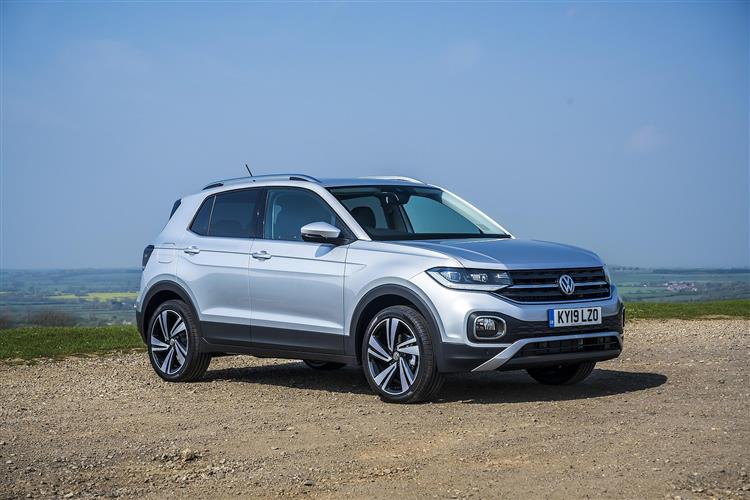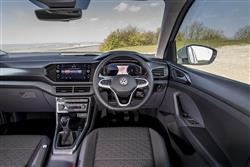CROSS PITCHING (some text hidden) --NONE--
By Jonathan Crouch
Introductionword count: 65
Think of a Volkswagen Polo with a more adventurous image, a slightly larger cabin and a more flexible interior. You're picturing this car, Volkswagen's smallest SUV, the T-Cross, launched back in 2019. It's trendy, quite sophisticated and very acceptably efficient, thanks to its 1.0-litre TSI petrol and 1.6 TDI diesel engine options. And you can make it very much your own. What's not to like?
Modelsword count: 9
5dr SUV (1.0 TSI, 1.5 TSI / 1.6 TDI)
Historyword count: 423
It may seem as if Volkswagen has a considerable number of family SUVs in its model line-up but the surprising truth is that until the introduction of this T-Cross model, the Wolfsburg brand had been completely absent from one of this crucial segment's fastest-growing sectors; that for supermini-based SUVs. Nissan launched the Juke in 2011. Renault announced the Captur in 2014. It wasn't though, until late 2018 that we first saw this T-Cross, Volkswagen belatedly responding to the fact that the small SUV segment had by then doubled in size over the previous five years and was set to double again over the next five. This contender sloted into the company's range just below the Golf-based T-Roc. Which in turn sat below the Tiguan and Touareg SUVs in the company's line-up. The T-Cross was Polo-based and sat on the same MQB-A0 platform as its VW Group close cousins, the Skoda Kamiq and the SEAT Arona. The motor industry likes to think that customer preference for small tall models like this one is a recent phenomenon. Actually, it isn't; cars like the Renault 4 were offering this kind of packaging back in the Seventies, though admittedly not with the kind of 'urban crossover' vibe that characterises the T-Cross and its ilk. This doesn't translate into any actual extra rough road capability of course; supermini-SUV buyers don't want that. But it may well sugar the pill if you've decided the time has come to downsize from something slightly larger. As will the surprising amount of space in this car's cabin. Given the whole 'short-tall' theme, you might expect this car to offer more headroom than a supposedly larger Golf. But you might well be surprised to find that this T-Cross can also offer considerably more boot space than that car, courtesy of its sliding rear bench, a key differentiating feature over this model's SEAT and Skoda counterparts. Other surprises for original buyers included the kind of brightly coloured optional trimming packs that once would have been at odds with Volkswagen's traditionally conservative image. And ride quality equally contrary to the normal notion that because of extra height, an SUV must always ride more firmly than the ordinary hatch it's based upon. The T-Cross was originally offered with a 1.6 TDI diesel option, as well as the more familiar 1.0 TSI and 1.5 TSI petrol units, but the diesel was dropped in 2020. The T-Cross sold in its original form until mid-2023, when it was extensively facelifted. It's the pre-facelift 2019-2023-era models we look at here.
What You Getword count: 442
If you want a compact affordable Volkswagen SUV but find the brand's Golf-based T-Roc model a bit too fashion-conscious, then this Polo-based T-Cross will probably be just up your street. Despite the fact that it sits on an MQB-A0 platform supposedly designated for superminis, it's actually not much smaller than a T-Roc in overall size and has a boxier, more conventional shape that ought to make it a touch more practical inside. Inside, you sit quite commandingly by the standards of this class of car and it's easy to find a comfortable driving position thanks to loads of wheel and seat adjustment. You might wish that Volkswagen had taken a slightly more extrovert approach to cabin design here - it's well built and ergonomically almost faultless, but all a bit grey and dour. All models get an 8-inch centre-dash Composition Media' infotainment screen which delivers all the usual informational, telephone and entertainment options with assured cleverness. Avoid entry-level trim and you also get the Volkswagen 'Car-Net' 'App-Connect' set-up you'll need for 'Apple CarPlay' and 'Android Auto' smartphone-mirroring. As an option on mainstream models, Volkswagen also offered a larger 10.25-inch 'Active Info Display' instrument screen, which replaced the usual conventional dials that you otherwise get in the instrument cluster. There's plenty of storage space too, including big door bins, under-seat stowage and a deep forward compartment ahead of the gearstick. And in the rear? Well six foot adults who might normally grumble at the prospect of long distance rear seat confinement in any supermini-based model need have no worries about the prospect of riding in this one. We should also mention this car's party piece - its sliding rear bench, which was standard-fit across the range. The seat base slides over a range of 14cms, though in its most forward position, legroom would be virtually non-existent unless the people in front were very short indeed. When it's pushed all the way back though, there's vastly more leg room than you'd ever expect a car of this size would be able to provide. Finally, let's talk about luggage space out back. You might hope that that the tall shape would free up considerably more boot capacity than you'd get in a Polo. Well that depends upon the position of that sliding rear bench. If it's pushed all the way back, there's 385-litres of space - just 34-litres more than a Polo, but easily enough for a buggy or a few large suitcases. If however, you were to push the bench right forward, capacity would rise to 455-litres - which is 10-litres more than you'd get in Volkswagen's T-Roc SUV from the next class up.
To see the full road test text contact us on 0330 0020 227
Pictures (high res disabled)

.jpg)
|
.jpg)
|
.jpg)
| |||
.jpg)
|
.jpg)
|
.jpg)
| |||
.jpg)
|

|
Scoring (subset of scores)
Category: Crossover or SUV 4x4s
| Performance | |
| Handling | |
| Comfort | |
| Space | |
| Styling, Build, Value, Equipment, Depreciation, Handling, Insurance and Total scores are available with our full data feed. | |



